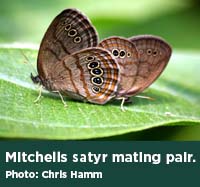About Fens
 Prairie fens are alkaline pH wetlands that occur where groundwater-fed springs come to the soil surface. They are very rare globally, but are most common in glaciated areas of the Midwestern United States. Prairie fens are dominated by sedges, grasses and other grasslike vegetation, and contain very high plant diversity, including grass and wildflower species found in drier prairies. This plant community is home to many rare species, including the federally endangered Mitchell’s satyr butterfly. These communities are wet throughout the growing season, so that plant material does not decompose and peat builds up over time. Prairie fen communities historically occurred in a gradient of habitats that included oak savanna and other open-structured fire-dependent plant communities. Today, those areas are likely to be oak-dominated forests, or rural or residential development.
Prairie fens are alkaline pH wetlands that occur where groundwater-fed springs come to the soil surface. They are very rare globally, but are most common in glaciated areas of the Midwestern United States. Prairie fens are dominated by sedges, grasses and other grasslike vegetation, and contain very high plant diversity, including grass and wildflower species found in drier prairies. This plant community is home to many rare species, including the federally endangered Mitchell’s satyr butterfly. These communities are wet throughout the growing season, so that plant material does not decompose and peat builds up over time. Prairie fen communities historically occurred in a gradient of habitats that included oak savanna and other open-structured fire-dependent plant communities. Today, those areas are likely to be oak-dominated forests, or rural or residential development.
 Because different amounts of groundwater are available throughout a prairie fen, the community commonly contains several zones of vegetation with different plant species and vegetation height: inundated flats, sedge meadow, marl flat, and wooded fen. The sedge meadow is typically the largest component of the fen, and shrubby cinquefoil (Potentilla fruticosa), sedges, and wet prairie species joe-pye weed (Eupatorium maculatum), boneset (E. perfoliatum), and asters are common in this vegetation zone. See Michigan’s natural communities list for more information. Also, view sample pages of the book “Exploring the Prairie Fen Wetlands of Michigan” to learn about the species and vegetative communities within them.
Because different amounts of groundwater are available throughout a prairie fen, the community commonly contains several zones of vegetation with different plant species and vegetation height: inundated flats, sedge meadow, marl flat, and wooded fen. The sedge meadow is typically the largest component of the fen, and shrubby cinquefoil (Potentilla fruticosa), sedges, and wet prairie species joe-pye weed (Eupatorium maculatum), boneset (E. perfoliatum), and asters are common in this vegetation zone. See Michigan’s natural communities list for more information. Also, view sample pages of the book “Exploring the Prairie Fen Wetlands of Michigan” to learn about the species and vegetative communities within them.
Wetlands make up only 3 percent of the earth’s surface, yet they provide us with many benefits, including flood control, water purification, and carbon storage to help prevent global climate change. Because prairie fen is globally rare, it may disappear entirely if we don’t take measures to protect it. Prairie fens have unique plant and animal diversity due to the alkaline groundwater that feeds into them from surrounding areas, so if prairie fens disappeared, a number of plant and animal species would also likely go extinct. Prairie fens are home to many rare plants and animals, including the federally endangered Mitchell’s satyr butterfly and the eastern massasauga rattlesnake, a candidate species for federal endangered status and threatened in Michigan. In addition, recovery after peat mining or draining can take up to 10,000 years; peat deposition is a very slow process.



 Print
Print Email
Email